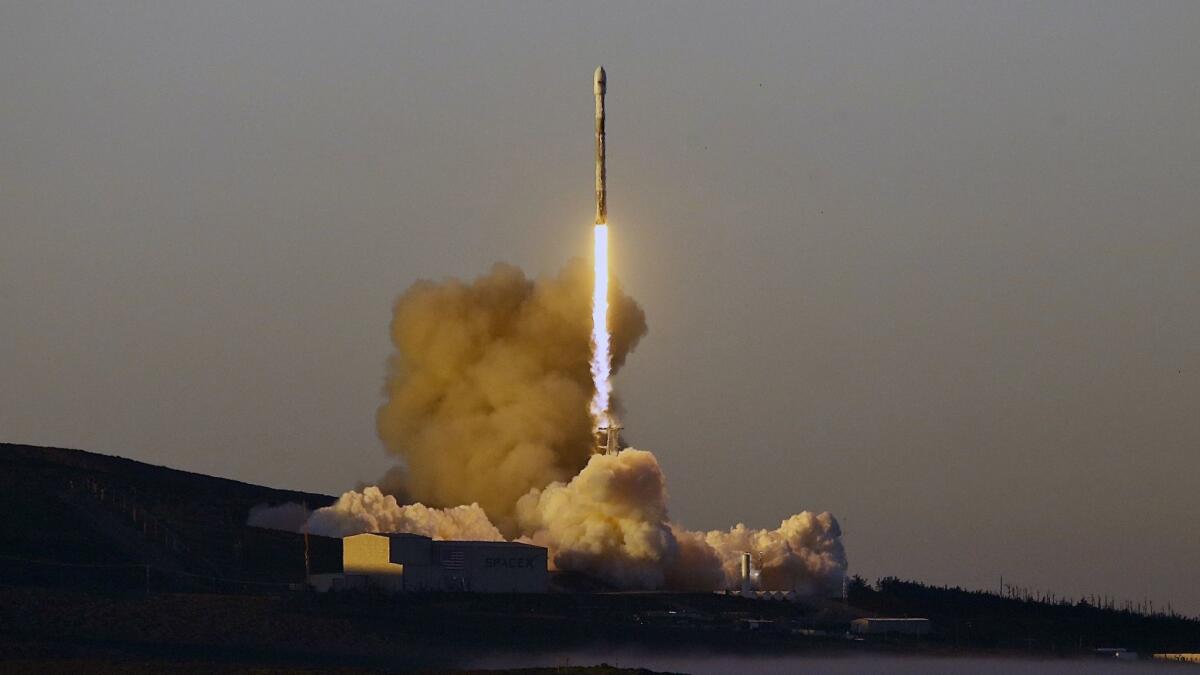Trump hurries to cut red tape slowing the commercial space industry

- Share via
A Falcon 9 rocket lifted off perfectly from pad 4E at Vandenberg Air Force Base on March 30, carrying aloft satellites for Iridium Communications Inc. Video from the vehicle flipped on 2 minutes and 35 seconds later, just in time for webcast viewers to witness the first stage falling to Earth and the second stage lighting up. “That’s gorgeous,” said Michael Hammersley, the SpaceX narrator.
The rocket was 90 miles high and the Earth’s curvature was coming into focus when Hammersley delivered a buzzkill: “A quick reminder,” he said. Video will be cut “due to restrictions placed on us by the National Oceanic and Atmospheric Administration.” The reason: paperwork.
SpaceX — the Elon Musk-led company based in Hawthorne whose full name is Space Exploration Technologies Corp. — ultimately received a commercial license from NOAA’s remote-sensing office, but the regulatory framework that requires such permits hasn’t been updated in decades. The red tape was emblematic of how rules governing 20th-century space travel aren’t well suited for the 21st century. That may be about to change.
In a bid to fully commercialize space, last year President Trump convened the first National Space Council in a generation. Now, he’s followed up on recommendations the panel issued in February by ordering the aerospace bureaucracy to remake itself, with at least two revolutions in mind: one in information technology and the other in spaceflight itself. On Thursday, Trump signed his second Space Policy Directive, designed to bring government oversight of space travel up to date.
When President George H.W. Bush assembled the previous National Space Council in 1989, the Soviet Union was still a force and regulators needed to consider only big, expensive spacecraft that launched periodically and were typically under federal contracts. Large space industry participants such as Northrop Grumman Corp., Lockheed Martin Corp. and Boeing Co. have worked with the government for decades and developed infrastructure necessary to comply with existing laws and regulations.
But in 2018, there are many more players. Dozens of space start-ups that don’t have the resources of their massive brethren are pushing the Trump administration for relief. Alongside the industry giants, upstarts such as Jeff Bezos’ Blue Origin, Relativity Space Inc., Vox Space and the 3.1-million-pound heavyweight in the room, SpaceX, now also sit on a National Space Council advisory panel.
“We just hope this directive translates into action quickly,” said Yotam Ariel, chief executive of Bluefield Technologies, a start-up backed by the venture capital firm Unshackled Ventures. “We’re one of many, many start-ups seeking commercial access to space right now, so the sooner regulations can be simplified, the better.”
Trump’s order mandates a broad review of a system that requires companies to undergo months of paperwork, and often hire teams of lawyers, to receive necessary permits and licenses. In the case of the SpaceX launch in March, the rule in question was a throwback. A law on “remote sensing,” such as broadcasting pictures of the Earth from altitude, was put in place in 1992 to protect against foreign snooping. To get past it, there are lots of forms to fill out.
The administration’s new directive is pushing two specific agencies to modernize, and many others to weigh in. The U.S. Department of Transportation is required to plan before February 2019 a new system for managing both launch and reentry — the latter of which didn’t exist as a regular category in a commercial context until SpaceX’s Musk showed that his rockets can be recovered.
“When these rules were written, there was never even a thought of reentry,” said Eric Stallmer, president of the Commercial Spaceflight Federation. Trump’s new “rules and regulations were really required, and well overdue.”
The text of the directive, which was released late Thursday, calls for a “reorganization of the Department of Commerce.” The department, which includes NOAA, will take on new rules for remote sensing. Trump’s order gives Commerce Secretary Wilbur Ross 30 days to plan a “one-stop shop” for commercial spaceflight companies, and requires him to consolidate space policy assets under his office, to the extent allowed by law.
The department announced Thursday that Ross would propose that Congress establish a Space Policy Advancing Commercial Enterprise (SPACE) Administration, drawing into one office activities currently overseen by other Commerce Department agencies. The department is also directed to review regulations for the 1992 Land Remote Sensing Policy Act and revoke, revise or rewrite them in line with Trump’s new policy.
Trump’s directive also addresses the availability of space radio spectrum and how that will be divided up, and it gives the National Space Council 180 days to turn in a report about commercial space industry export licensing.
As the agencies seek to clear the national launchpad, companies are figuring out how to execute their goals in the heavens.
“Now is the time for swift and bold action,” SpaceX President and Chief Operating Officer Gwynne Shotwell told the National Space Council at its first meeting in October. “A permanent presence on the moon and American boots on the surface of Mars are not impossible, and they are not long-term goals.”
Roston writes for Bloomberg.
More to Read
Inside the business of entertainment
The Wide Shot brings you news, analysis and insights on everything from streaming wars to production — and what it all means for the future.
You may occasionally receive promotional content from the Los Angeles Times.










